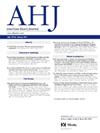PE-TRACT试验的基本原理和设计-一项多中心随机试验,评估导管导向治疗中危性肺栓塞的疗效。
IF 3.7
2区 医学
Q1 CARDIAC & CARDIOVASCULAR SYSTEMS
引用次数: 0
摘要
中度风险肺栓塞(PE)患者的最佳治疗方法尚不确定,这些患者有右心功能障碍(由影像学和心脏生物标志物联合确定),但血压正常。尽管使用抗凝治疗,这些患者的长期功能能力下降,生活质量下降。导管定向治疗(CDT)是一种很有前景的治疗急性PE的方法,可以快速清除血栓并可能改善心功能障碍。然而,CDT有风险且成本高,并且与单独抗凝相比,CDT是否能改善长期心肺健康和/或生活质量尚不清楚。因此,我们正在进行一项开放标签、评估盲、多中心随机试验,即肺栓塞:导管导向治疗的血栓去除(PE- tract)研究,比较500例中危PE患者的CDT +抗凝(CDT组)和单独抗凝(No-CDT组)。主要的研究假设是,与不进行CDT相比,CDT将在3个月时增加心肺运动试验的峰值摄氧量(峰值VO2),并在12个月时降低纽约心脏协会(NYHA)等级。这两个主要疗效结果将按顺序使用“把关”程序进行分析;对于NYHA类进行比较,必须首先证明CDT显著增加了峰值耗氧量。还将评估安全性和成本效益。完成后,PE- tract将为CDT治疗中危性PE的获益和风险提供重要证据,与单独抗凝相比。本文章由计算机程序翻译,如有差异,请以英文原文为准。
Rationale and design of the PE-TRACT trial: A multicenter randomized trial to evaluate catheter-directed therapy for the treatment of intermediate-risk pulmonary embolism
Background
The optimal management of patients with intermediate-risk pulmonary embolism (PE), who have right heart dysfunction (determined by a combination of imaging and cardiac biomarkers) but a normal blood pressure, is uncertain. These patients suffer from reduced functional capacity and a lower quality of life over the long-term, despite use of anticoagulant therapy. Catheter-directed therapy (CDT) is a promising treatment for acute PE that rapidly removes thrombus and potentially improves cardiac dysfunction. However, CDT has risk and is costly, and it is not known whether it improves long-term cardiorespiratory fitness and/or quality of life compared with anticoagulation alone.
Methods
We are therefore conducting an open-label, assessor-blinded, multicenter randomized trial, the Pulmonary Embolism: Thrombus Removal with Catheter-Directed Therapy (PE-TRACT) Study, to compare CDT plus anticoagulation (CDT group) with anticoagulation alone (No-CDT group) in 500 patients with intermediate-risk PE. The primary study hypothesis is that CDT will increase the peak oxygen uptake (peak VO2) with cardiopulmonary exercise testing at 3 months and reduce New York Heart Association (NYHA) Class at 12 months compared with No-CDT. These 2 primary efficacy outcomes will be analyzed sequentially using a “gatekeeping” procedure; for NYHA class to be compared, peak oxygen consumption must first be shown to be significantly increased by CDT. Safety and cost-effectiveness will also be assessed.
Conclusion
When completed, PE-TRACT will provide important evidence regarding the benefits and risks of CDT to treat intermediate-risk PE compared with anticoagulation alone.
Trial Registration
clinicaltrials.gov: NCT05591118.
求助全文
通过发布文献求助,成功后即可免费获取论文全文。
去求助
来源期刊

American heart journal
医学-心血管系统
CiteScore
8.20
自引率
2.10%
发文量
214
审稿时长
38 days
期刊介绍:
The American Heart Journal will consider for publication suitable articles on topics pertaining to the broad discipline of cardiovascular disease. Our goal is to provide the reader primary investigation, scholarly review, and opinion concerning the practice of cardiovascular medicine. We especially encourage submission of 3 types of reports that are not frequently seen in cardiovascular journals: negative clinical studies, reports on study designs, and studies involving the organization of medical care. The Journal does not accept individual case reports or original articles involving bench laboratory or animal research.
 求助内容:
求助内容: 应助结果提醒方式:
应助结果提醒方式:


